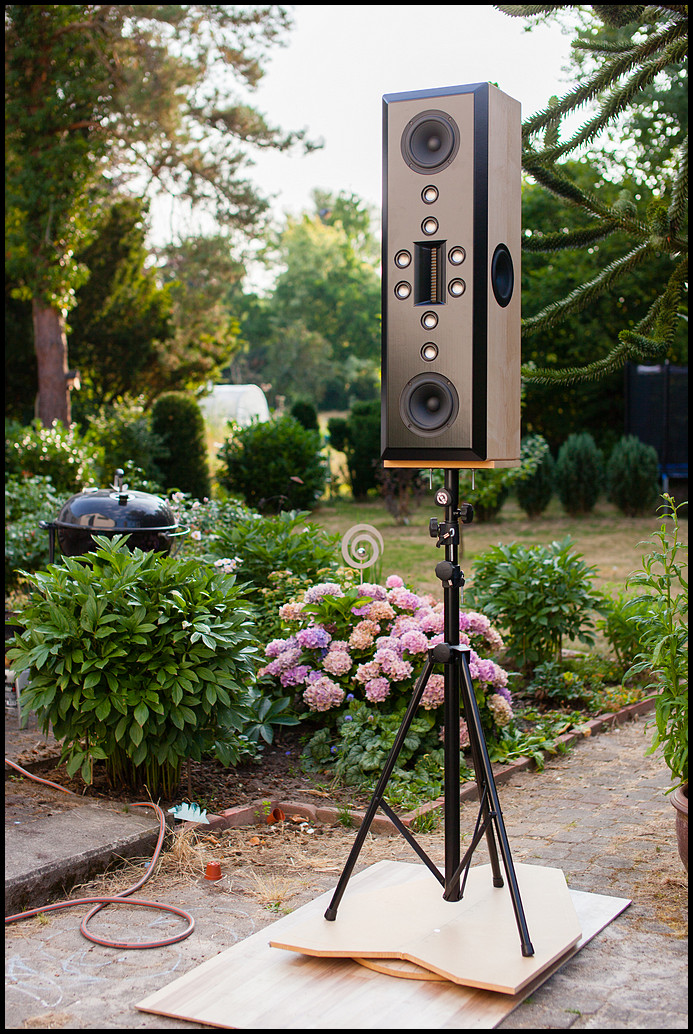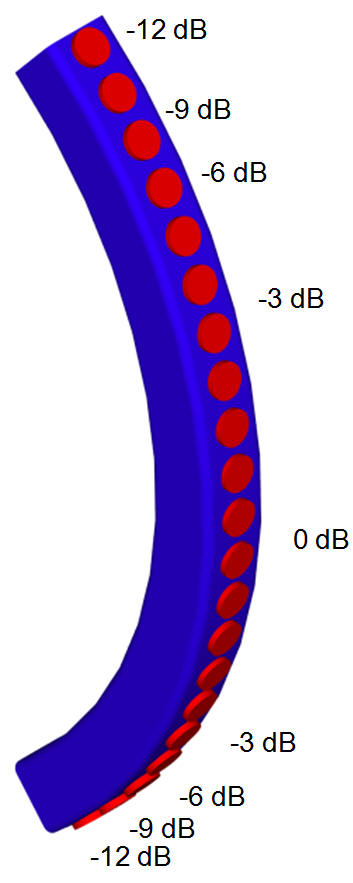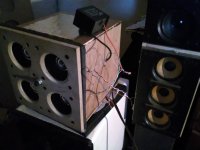A different cut on a similar design is this one:
DNA Sequence Speakers dipole open baffle woofer high efficiency point source array midrange tweeter treble loudspeaker
DNA Sequence Speakers dipole open baffle woofer high efficiency point source array midrange tweeter treble loudspeaker
Polk Audio could have put the tweeter on the center on the "Monitor 12", but they didn't
Vintage Polk Audio Speakers: Monitor 12
I guess since they are floor standing speakers, the tweeter would have been too low.
"SDA 1C" is similar, but with two tweeters
Vintage Polk Audio Speakers: SDA 1C (Real Wood)
"SDA 2" getting even more strange, one midrange 'deleted' but still two tweeters, this time horizontally.
Vintage Polk Audio Speakers: SDA 2
Last but not least, "SDA SRS", eight midranges and four tweeters vertically positioned in the center.
Vintage Polk Audio Speakers: SDA SRS
Could have used that one back in the day.. 😀
Vintage Polk Audio Speakers: Monitor 12
I guess since they are floor standing speakers, the tweeter would have been too low.
"SDA 1C" is similar, but with two tweeters
Vintage Polk Audio Speakers: SDA 1C (Real Wood)
"SDA 2" getting even more strange, one midrange 'deleted' but still two tweeters, this time horizontally.
Vintage Polk Audio Speakers: SDA 2
Last but not least, "SDA SRS", eight midranges and four tweeters vertically positioned in the center.
Vintage Polk Audio Speakers: SDA SRS
Could have used that one back in the day.. 😀
The SDA speakers do crosstalk cancellation, and are not a conventional array.
See: New Frontiers in Crosstalk Cancellation with MiniDSP
IMHO, the best way to do crosstalk cancellation, by far, is to put the cancellation speakers near the listener. When you put them near the speaker the cancellation signal kills the dynamics and kills the bass. When you put the cancellation speakers by the listener, it simply widens the soundstage.
See: Crazy Wide Soundstage | DiyMobileAudio.com Car Stereo Forum
See: New Frontiers in Crosstalk Cancellation with MiniDSP
IMHO, the best way to do crosstalk cancellation, by far, is to put the cancellation speakers near the listener. When you put them near the speaker the cancellation signal kills the dynamics and kills the bass. When you put the cancellation speakers by the listener, it simply widens the soundstage.
See: Crazy Wide Soundstage | DiyMobileAudio.com Car Stereo Forum
Last edited:
The SDA speakers do crosstalk cancellation, and are not a conventional array.
So their midranges are double wired from the back? Bass and the tweeters are not?
I would imagine the optimum listening area is not very wide for that kind of speakers.
Last edited:
McIntosh Labs XR100, bunch of small mid range drivers and some of them are for hi mid and some low
Would there be any cancellation issues doing a setup like this? What if it’s two woofers facing each other like in a 4 door car? Would they potentially cancel each other out?
I would think that the original Unity patent would cover all designs not trying to achieve increased directivity from more distant driver-center spacing.
I do not see midrange drivers in a circle, do you?McIntosh Labs XR100, bunch of small mid range drivers and some of them are for hi mid and some low
This one does…
Last edited by a moderator:
That's true, since we included pretty much already everything in the market here, I thought it was a good idea to also include some of other similar stuff too. By similar I mean design goals and having more mid range drivers than usual.
I think that speaker in your attachment was already introduced in this topic on post #6. Dna Sequence.
I think that speaker in your attachment was already introduced in this topic on post #6. Dna Sequence.
https://www.diyaudio.com/community/threads/hornflower-2-way-point-source.386363/
:-D
Still evaluating - so much new in these compared to what I'm used to...
//
:-D
Still evaluating - so much new in these compared to what I'm used to...
//
Wow, nice work and certainly in a circle 🙂
I would imagine that in the room, the wall behind is also part of the audio experience.
Btw, where did you get the inspiration, don't say that from this topic? 😀
I would imagine that in the room, the wall behind is also part of the audio experience.
Btw, where did you get the inspiration, don't say that from this topic? 😀
Did anyone mention this one? https://www.diyaudio.com/community/...directivity-and-horbach-keele-filters.284117/

Eventually it evolved into this:

Eventually it evolved into this:
McIntosh Labs XR100, bunch of small mid range drivers and some of them are for hi mid and some low
I've been studying this stuff for a while.
One of the "Eureka" moments that I had, was the realization that instead of power tapering a line array, you can just add more elements horizontally.

For instance, in the Don Keele CBT array, the elements in the center are getting 1000% as much power as the elements at the edge of the array.
https://www.keele-omholt-technologies.com/papers/Harman Gallery of CBT Prototypes.pdf
Keele addresses this by using a ton of resistors.
The problem with resistors is that it massively lowers the headroom of the array. Basically the drivers receiving full power are going to distort long before the drivers reaching 10% power are going to distort.
So there's a simple fix: put more drivers at the center of the array.
Of course, there's no free lunch, and you put ten drivers horizontally at the center of the array, the horizontal beamwidth is going to vary depending on the vertical angle.
But you can compromise, and simplify the crossover, by using more drivers at the center of the array than at the edges of the array. Ten drivers horizontally probably isn't practical, but four might work.
Of course, once you go down this rabbit hole, two dimensional arrays like this start making more sense: https://www.diyaudio.com/community/...raight-cbt-with-passive-xos-and-no-eq.330031/
Yes, everything below 1,5k has had a bounce on the wall - It was a friend who had made som simulations about turning the speakers towards the wall which looked quite good so I wanted to try that... 🙂Wow, nice work and certainly in a circle 🙂
I would imagine that in the room, the wall behind is also part of the audio experience.
Btw, where did you get the inspiration, don't say that from this topic? 😀
My analysis so far is that the LF of that speaker has no immediate problems so I'm contemplating a larger version with 6 pcs of 5", still facing backwards and a larger wave-guide. Perhaps with a 1,4" driver for lower x-over...
//
Indeed, just mimic CD horn (Mantaray, et al) design in the 'flat', so to speak. 😉One of the "Eureka" moments that I had, was the realization that instead of power tapering a line array, you can just add more elements horizontally.
Using small drivers hugely limits the choice of drivers available, and most often limits the available quality too. Using lots of cheap little drivers does not somehow magically make them superior to a single well-engineered unit. It's mostly done for novelty value...
Last edited by a moderator:
- Home
- Loudspeakers
- Multi-Way
- Midrange drivers in a circle?

